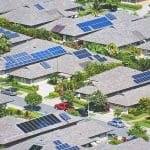WHAT IS LICHEN?
Lichen is a very common plant that can grow basically anywhere, yet are frequently misunderstood. Many people would tell you it is moss, some would say algae and very few would say fungi. In truth, the former two are both correct. It is part algae, part fungi and zero parts moss.
Strangely, Lichens are a complex symbiotic partnership of two separate organisms, a fungus and an alga. The algae side photosynthesizes, which converts sunlight into food while the fungus side grows and spreads.
The fungus also protects the algae, enabling it to live in dry, arid climates it would otherwise not be able to. This is why Lichen thrives in environments as versatile as the Sonoran Deserts to the rainforests of El Yunque National Forest in Puerto Rico to the high alpine tundras of Alaska.
Lichens are also valuable indicators of air pollutants because they absorb anything in the air, from heavy metals to carbon or sulfur. With a sample, scientists can determine air quality anywhere that lichen grows, which as discussed can be almost anywhere.
HOW DOES IT AFFECT SOLAR PANELS?
While Lichen are interesting and valuable organisms, they remain a sizable pest for the solar industry. Their adaptability only increases their peskiness as solar panel owners anywhere can be affected by them.
The complex nature of Lichens allow them a strong anchoring system, which makes it very difficult to remove without long, laborious hours of scrubbing. Plus their ability to live anywhere makes almost any environment one it can thrive in and therefore spread.
As with any coverage of rooftop solar panels, be it shade or bird droppings, the power output of the system will decrease according to the amount covered. The higher the percent of the surface area of the panel covered, the more the amount of solar energy produced will decrease.
So while a small amount of Lichen growth will result in a small decrease in percent efficiency, if ignored, can quickly cover the entire surface rendering even the highest efficiency panels nearly useless. Consequently, Lichen should be managed as quickly as possible.
Related Articles: What Affects Solar Panel Efficiency
WAYS TO PREVENT LICHEN GROWTH
As with most things, the best way to manage Lichen is to prevent it. Regular inspection and cleaning of your solar system can vastly aid in preventing Lichen development. This is especially true for regions prone to algae growth.
The most common method, and the only method we recommend is simply spray and wash. Using water only, spray the solar panels and use a long window cleaning pole with a soft brush head to knock off any debris, dirt or algae from the surface.
Repeating this process on a regular basis can effectively manage small amounts of Lichen growth or keep it from taking up residence on your panels altogether.
HOW TO CLEAN: LEAVE IT TO A PROFESSIONAL
However, if your solar panel system is already significantly affected or covered by Lichen, it is best to call a professional.
HOW IT ANCHORS
As previously mentioned, the dual organism structure of the plant allows for significant anchoring systems, two different types to be exact. The first is through the use of Rhizines, fungal filaments that extend from the medulla (the cotton-like structure on the underside).
The second is through the use of Holdfasts which is an extension of the medulla itself. The type of Lichen that uses this anchoring system is called Umbilicate Lichens because the holdfast strongly resembles an umbilical cord.
IMMENSELY DIFFICULT TO REMOVE
The only aspect you need to understand from the anchoring system information is that Lichens are hard to remove. You can scrape away the flower, the upper layer of Lichen, and be fooled into thinking the entire organism has been cleaned off.
Yet with further inspection, you will find the medulla, the cotton-like substructure mentioned before, will have most likely remained and provided a base for the Lichen to regrow with ease. Short of chemicals, the only true way to successfully remove it is through elbow-grease and scrubbing.
THE RISKS OF DIY REMOVAL
This can be a high risk situation for your panels for a number of reasons. The first, solar panels are highly fragile and brittle. Any unintended body weight on top of a panel could be very harmful, even causing the panel to crack or break.
Plus, if too abrasive of a brush is used to scrub the panels, it could irrevocably damage the surface.
The other option, which we highly advise against, is to use chemicals. The problem with this option is that for one, the chemicals could harm your panels or your roof or be an environmental toxin. In addition, using a chemical could void the warranty of your solar system.
Related Articles: How to Clean Solar Panels
CALL PUR SOLAR
At the end of the day, the process of removing Lichen is labor intensive and highly risky to your solar system. It is absolutely in your best interest to call your solar installer for assistance or advice on best management procedures.
Thankfully at Pur Solar every purchase of a solar project, be it commercial or residential solar systems, comes with a lifetime of free maintenance. So frankly, why risk it?
Give us a call at (866) 204-9886 or click here and one of our knowledgeable experts will be happy to help.





